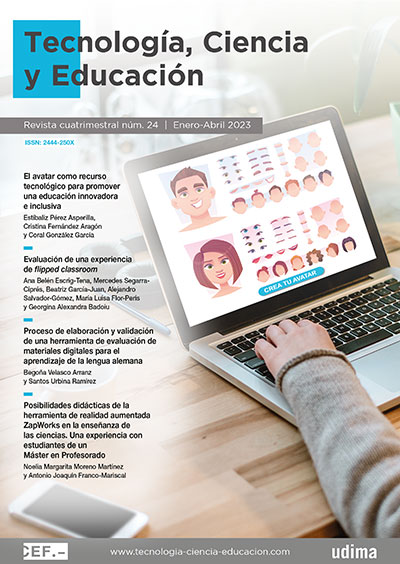The avatar as a technological resource to promote an innovative and inclusive education
DOI:
https://doi.org/10.51302/tce.2023.3397Keywords:
avatar, education in virtual environments, initial teacher training, communication training, gender perspective, innovative teaching resources, STEMAbstract
This paper has won the 1st Financial Studies 2022 Award in the category of Education and New Technologies.
Education in virtual environments offers some advantages over traditional education, such as greater flexibility and more control over the time, space and pace of the learning process. However, this type of education also entails a series of challenges for students (men and women), who often feel isolated and lose motivation. Also, the lack of female references in STEM (science, technology, engineering and mathematics) is considered one of the causes of the gender gap in these disciplines.
The use of innovative tools in the virtual classroom, such as the avatar, can foster the understanding of the contents and generate a feeling of closeness. In addition, using avatars as a common thread to incorporate the gender dimension in the classroom allows to show reference models and promotes reflection on stereotypes.
This study shows that using avatars to accompany and guide the students not only improves the virtual learning experience, but also promotes a change in mentality around gender. Gender stereotypes are transmitted, among others, through school and media. Thus, it is essential to raise awareness on gender issues among the initial training of teachers and future communication professionals to promote, from the educational space, a change towards a more egalitarian society.
Supporting Agencies
Este trabajo se enmarca en el proyecto de innovación educativa «Dinamización del aula virtual mediante la creación de avatares de grandes científicas e inventoras en la historia de la humanidad» (código ID-UDIMA-2020-04).
Downloads
References
Álvarez, M. (2007). La historia de la ciencia en la formación del profesorado de Ciencias Naturales. En M. R. Quintanilla Gatica y A. Adúriz-Bravo, A. (Eds.), Enseñar ciencias en el nuevo milenio: retos y desafíos (pp. 239-256). Pontificia Universidad Católica de Chile.
Blanco Martínez, A. y Anta Fernández, P. (2016). La perspectiva de estudiantes en línea sobre los entornos virtuales de aprendizaje en la educación superior. INNOEDUCA. International Journal of Technology and Educational Innovation, 2(2), 109-116.
Camacho González, J. (2017). Identificación y caracterización de las creencias de docentes hombres y mujeres acerca de la relación ciencia-género en la educación científica. Estudios Pedagógicos, 43(3), 63-81. http://dx.doi.org/10.4067/S0718-07052017000300004
Camacho González, J. (2018). Educación científica no sexista. Aportes desde la investigación en didáctica de las ciencias. NOMADÍAS, 25, 101-120.
Contreras Espinosa, R. S. (2017). Gamificación en escenarios educativos. Revisando literatura para aclarar conceptos. En R. S. Contreras Espinosa y J. L. Eguia (Eds.), Experiencias de gamificación en aulas. InCom-UAB Publicacions, 15. Institut de la Comunicació, Universitat Autònoma de Barcelona.
Díaz-Delgado, N. (2018). Gamificar y transformar la escuela. Revista Mediterránea de Comunicación, 9(2), 61-73. https://doi.org/10.14198/MEDCOM.12457
Fresno García, M. del. (2011). Netnografía. Universitat Oberta Catalunya.
Guarinos, V., Caro, F. J. y Cobo Durán, S. (2018). La igualdad de género en los estudios de grado en comunicación: la transversalidad imaginaria. Prisma Social, 22, 296-325. https://revistaprismasocial.es/article/view/2571
Gutiérrez Giraldo, M. C., Agudelo Cely, N. y Orlando Caro, E. (2016). La etnografía educativa virtual y la formación de docentes. Praxis & Saber, 7(15), 41-62. https://doi.org/10.19053/22160159.v7.n15.2016.5722
Hine, C. (2004). Etnografía virtual. Universitat Oberta Catalunya.
Johnson, W. L., Rickel, J. W. y Lester, J. C. (2000). Animated pedagogical agents: face-to-face interaction in interactive learning environments. International Journal of Artificial Intelligence in Education, 11, 47-78.
Kerkhoven, A. H., Russo, P., Land-Zandstra, A. M., Saxena A. y Rodenburg, F. J. (2016). Gender stereotypes in science education resources: a visual content analysis. PlosOne, 16. https://doi.org/10.1371/journal.pone.0165037
López-Navajas, A. (2014). Análisis de la ausencia de las mujeres en los manuales de la ESO: una genealogía de conocimiento ocultada. Revista de Educación, 363, 282-308. https://doi.org/10.4438/1988-592X-RE-2012-363-188
Manassero, M. A. y Vázquez, Á. (2002). Gender stereotypes and language in science textbooks. Culture and Education, 14, 415-429.
Martha, A. S. D. y Santoso, H. B. (2019). The design and impact of the pedagogical agent: a systematic literature review. Journal of Educators Online, 16(1). https://doi.org/10.9743/jeo.2019.16.1.8
Melo-Solarte, D. S. y Díaz, P. A. (2018). El aprendizaje afectivo y la gamificación en escenarios de educación virtual. Información Tecnológica, 29(3), 237-248. http://dx.doi.org/10.4067/S0718-07642018000300237
Park, S. (2016). Virtual avatar as an emotional scaffolding strategy to promote interest in online learning environment. En S. Y. Tettegah y M. Gartmeier (Eds.), Emotions and Technology: Emotions, Technology, Design, and Learning (pp. 201-224). Academic Press.
Pate, A. L. (2020). Diverse avatars and inclusive narratives in virtual reality biology simulations. The Emerging Learning Design Journal, 7(1), 16-19.
R Core Team. (2021). R: a language and environment for statistical computing. R Foundation for Statistical Computing.
RAE. (s. f.). Avatar. Diccionario de la lengua española [online]. https://dle.rae.es/avatar?m=form
Raposo-Rivas, M. y Cebrián de la Serna, M. (Coords.). (2020). Tecnologías para la formación de educadores en la sociedad del conocimiento. Pirámide.
Rosemberg F., Moura, N. C. y Silva, P. V. (2009). Fighting sexism in textbooks: agenda construction and its critics. Cadernos de Pesquisa, 39(137). https://doi.org/10.1590/S0100-15742009000200009
Saura, A. (2011). Exposición itinerante-AVATARES. Sistemas, Cibernética e Informática, 8(2), 55-60. http://www.iiisci.org/Journal/CV$/risci/pdfs/HPP106ES.pdf
Schroeder, N. L. y Traxler, A. L. (2017). Humanizing instructional videos in physics: when less is more. Journal of Science Education and Technology, 26(3), 269-278. https://doi.org/10.1007/s10956-016-9677-6
Solsona, N. (2007). Las mujeres en la historia de la ciencia. En M. Quintanilla y A. Adúriz-Bravo (Eds.), Enseñar ciencias en el nuevo milenio: retos y desafíos (pp. 37-63). Pontificia Universidad Católica de Chile.
Teixes, F. (2015). Gamificación: motivar jugando. Universitat Oberta Catalunya.
Wang, J. y Antonenko, P. D. (2017). Instructor presence in instructional video: effects on visual attention, recall, and perceived learning. Computers in Human Behavior, 71, 79-89. https://doi.org/10.1016/j.chb.2017.01.049
Downloads
Published
How to Cite
Issue
Section
License
Copyright (c) 2023 Estíbaliz Pérez Asperilla, Cristina Fernández Aragón, Coral González García

This work is licensed under a Creative Commons Attribution-NonCommercial-NoDerivatives 4.0 International License.

























